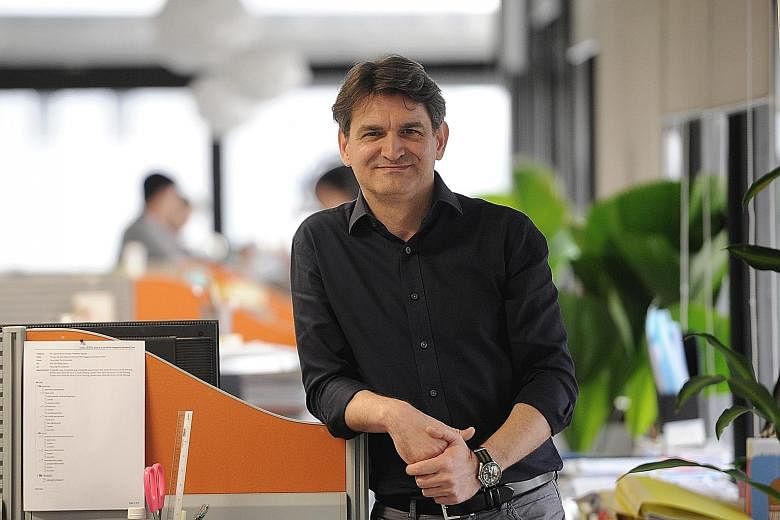The finance industry brings to mind men and women in stuffy suits and not so much creativity, but OCBC Bank head of experience design Bojan Blecic is changing that image.
The Croatia-born Singapore permanent resident, who grew up in Zurich, is a trained architect who provides a different perspective.
As head of experience design, his role is to guide his team of 10 Singaporean designers to improve everything that interacts with the consumer, from products and branches to even the finest details in administrative documents and forms.
Mr Blecic, 48, says: "When I started in 2010, there was no team. It took a while to build it because it was not a common thing.
"When you try to find other designers to join a bank, it's very challenging because it's not something on their career path."
Mr Blecic himself took a while before veering onto the path less known to architects. After graduating from the Swiss Federal Institute of Technology in 1994, he worked as an architect in Berlin, Germany - "just one out of 200 people".
After a few years, he returned to Zurich where he met his former schoolmates, and they started a business providing design services to architects such as artist's impressions. That business, which closed after about three years, opened the doors to the start of his career in banking.
"We were sharing some projects at an innovation fair. A banker showed up and said he wanted to do something together. After a while, he said, 'Why don't you join us?'" That was how Mr Blecic landed a role as head of usability at Swiss bank Credit Suisse in Zurich in 2000, where his responsibilities grew, and he moved on to focus on customer experience before leaving in 2009.
"I've had the chance to be exposed to the corporate world and entrepreneurship, which I think everyone should do once in their lives. This helps you to appreciate the good things in both worlds.
"For instance, when you're independent, the good thing is that you make all the decisions, but the bad thing is you make all the decisions. You're responsible for them in a direct way."
The entrepreneurial bug bit him again, and he set up Belief Partners in 2009, a design consultancy for financial services firms in Zurich.
Somehow, he came across a newspaper posting from "a bank in Singapore" that was looking for a head of customer experience.
"From a perspective of someone who's running a company, my partner and I thought this bank would be interested in some consultancy work as our customer.
"So we decided to find out and the easiest way was to just send our CV and ask about our job. The company turned out to be OCBC but they didn't want to work with consultants," he said.
The bank told him that to make things sustainable, it needed to build an internal team and was open to discussions.
Mr Blecic says: "My question to the then chief executive was why did he want to do that, and why was customer experience important to him. I asked because after working for nine years in Credit Suisse, I had a very good sense of how hard it is to make things happen in a big company."
He notes that firms often talk about how they want to be customer-centric and oriented, but it is hard to put into practice.
"The reality is that there is such a big complexity that it's very hard to move things because there are processes, policies and rules that have been set to run the company in an efficient way, and that are very hard to move and change.
"Those have also proven that it's the right way to do it because the company is successful."
Mr Blecic recalls former OCBC chief executive David Conner telling him that the bank wanted to differentiate itself in a crowded industry, to provide more value.
"It was easy for customers to compare products between different banks. He added that most banks compete exclusively on price and, in his opinion, this was an approach that would not help OCBC to meet the strategic objectives."
Mr Blecic notes that this has been happening for a long time in finance, where the industry got used to "innovating by copying each other".
He said yes to joining the bank and moved here in 2010 to a country and region he was completely unfamiliar with.
It was challenging in the beginning working in a new function in a bank that was trying to improve age-old processes.
However, as the different departments in OCBC became familiar with the experience design team, Mr Blecic was able to work on reinventing the customer experience from within the bank.
"The team was involved in redesigning several digital platforms, from Internet banking, the apps on iPad, the website of OCBC - our project simplified it in such a way that from 20,000 pages of information when we started, we ended with 600. We managed to remove 19,400 pages of information after we realised that very few customers were in need of it. Things are now much easier to find and understand, so we have a more attractive website that requires remarkably less effort to navigate through."
Maintenance has also been cut down by $500,000 a year, he adds, and things are "faster, easier and more efficient".
Forms were redesigned as well. For instance, at least 20 per cent of about 2,400 to 2,500 forms of a certain type were filled up wrongly each month. "It was not the customers' fault but that the form was so complicated to fill out."
He notes that after the redesign, only 1 per cent of about 1,800 to 1,900 forms are filled incorrectly.
"And we have 500 forms less, so what happened? We realised those were re-submitted forms that were now no longer needed."
Not only does this save time and cost for the bank, but also for customers as well.
Being a trained architect - "I'm an architect in the deepest of my soul," says Mr Blecic - has given him the necessary skills he needed in his unusual career path.
"Understanding the customer, how to connect and resonate with them, what they value and what motivates them is part of the design job. The designer understands the customer," he says.
"One thing they teach you in school is to listen to and understand the customer.
"After that, you present your ideas and sketches, and you keep understanding what is relevant and important to them. The product evolves until it makes sense for both of us."


